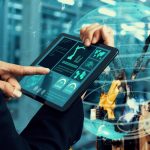Digitalization of power generation in times of transition
Digitalization holds great promise for the power generation industry. However, a range of internal and market challenges can constrain its effective uptake and implementation for those early in the digital journey.
Innovative companies that approach digitalization strategically, balancing the short and longer term objectives of the business, will gain a significant competitive advantage, improving their ability to adapt and thrive.
Industry, transformed by Digitalization in Power Sector
We are in the middle of two separate but closely related revolutions that are reshaping the entire value chain of power generation.
The first is the energy revolution. The industry is moving from conventional, centralized and well-controlled bulk generation to one that includes distributed and weather-dependent production; from stable, well-defined load profiles to more volatile and reverse power flows.
Since 2010 the global renewables capacity has increased by 8 to 10 percent year on year, with over 150 GW added annually representing over two thirds of all capacity addition. In Europe, 27 percent of energy generation already comes from renewables.
The second is an industrial revolution. This involves the move from isolated, underutilized assets and people to dynamic, globally connected operational models that enable real-time insight, optimised decision making and automated processes.
These revolutions bring both opportunities and challenges for the power generation industry.
On the one hand, there is increased market and operational complexity, knowledge retention and acquisition challenges in developed and developing markets respectively, regulatory compliance burdens and dynamic pricing pressures.
At the same time, there are a range of new digital solutions available, designed to address these very challenges and enable flexible new business models.
In these times of volatility and change, the one certainty is that standing still is not an option. Digitalization needs to be embraced strategically to sustain long term competitive advantage, while delivering immediate tactical requirements.
Approaching Digitalization in Power Sector
Digital solutions have become powerful tools to manage the complexity of the current business environment. Rapid advances in sensors, control systems, industrial software and artificial intelligence are opening new ways of driving efficiency gains from existing operations and enabling new, more flexible business models with extensive opportunities for growth.
Utilities, including Power Generation, are recognizing that Industrial Internet of Things (IIoT) technologies can yield significant benefits and many are actively planning for future investment over the next 12-18 months. According to LNS Research, over half are planning to invest in their analytics capabilities, while more than a third plan to invest in sensing and smart grids, as well as their operations, automation and business systems.
The challenge however is when, how and why digitalization is approached. The context of change and volatility in the power industry has constrained the full utilization of digital and the significant benefits it can bring.
For power generation companies, the decision to invest in digitalization is often tactical and weighted against the multiple short term demands on cash flow such as aging infrastructure, rising compliance costs and workforce replacement.
Compared to these immediate needs, realizing the profound benefits of digital transformation can often appear long term, uncertain and ultimately an issue for tomorrow.
It can also be a challenge identifying the right partner to work with. Aside from their technical capability, there are key considerations that need to be addressed:
- What happens to our intellectual property?
- How do we know our data is secure?
- How do we know we won’t be locked-in to a proprietary system with significant cost implications in the future?
As a result, where digital solutions have been implemented, the approach has often been tactical, narrow and focused on short term objectives. Rather than achieving the full benefits of digitalization, siloed digital initiatives have proliferated and in some cases contributed to the very complexity they were designed to solve.
Achieving the Promise of Digitalization in Power Plants
To achieve the full benefits it promises, digitization needs to be approached in a way that is focused on a company’s strategic priorities and avoids the hype of a specific technology or solution – each sector and business has its own operational priorities and challenges. These may include heavy investment in legacy equipment, working in remote geographies or a shortage of necessary skills. For example, nearly 70 percent of the transformers used in the US are more than 25 years old.
This means that there is ‘no one-size fits all’ solution. Instead, a tailored solution is required that looks at the people, processes and technology involved in the company and how they operate together.
Digitalization can already offer a significant range of immediate operational and financial benefits:
- sensors, devices and software can enable operators to utilize a wide range of data in real-time and improve decision making;
- control systems enable improved performance and maintenance of vital infrastructure and equipment either on-site or remotely;
- advanced analytics enables predictive maintenance and simulation to optimize asset performance;
- remote monitoring and external support can address key human resource and knowledge retention issues.
The longer-term promise of digitalization is also starting to be realized. New, more agile operational and business models are now possible based on connectivity, optimized decision making and automated processes.
Cloud technology and secured remote services also enable a closer relationship with partners, securely enabled expertise to be accessed from outside the plant, and enabling companies to focus on strategic areas, such as adoption of new business models.
More about main qualities of Industrial IoT in the digital power plants
Digitalization of the power generation industry: Evolve, adapt and thrive
Digitalization of the power generation industry in already under way and gathering momentum. More and more companies are launching digital initiatives that encompass not only critical assets such as turbines, boilers and generators, but also smaller balance of plant systems that can significantly influence plant operation.
The benefits of digitalization are already measurable – according to LNS research, gains of 10 percent plus for productivity, maintenance and reliability are being achieved, compared to 1-2 percent for companies that don’t embrace digitalization.
Challenges such as skills shortages and cyber security are also only going to become more acute with implications for safety, efficiency, margin and ultimately operational viability.
For pioneering companies, there is the opportunity not just to survive the current challenges, but to use digitalization to adapt and thrive.
For example, with an industrial internet of things platform (IIoT) in place, the cost of digitizing an additional asset or process becomes marginal.
The key for success is to approach digitalization as a business issue with strategic implications. It requires solutions that provide tactical operational advantages in the short term, while simultaneously allowing evolution without obsolescence and the full transformation potential that digitalization promises.
For those companies that embrace it effectively, the opportunity is sustained competitive advantage, a reimagined business model and new opportunities for growth.
 The article was written by Susan Peterson-Sturm, Digital Lead for Energy Industries. She is an industrial control leader with 15 years’ experience working with energy companies to securely and efficiently scale digital solutions for industrial enterprise. Prior to joining ABB, Susan spent 10 years in various roles at GE developing, launching and operating software and security solution product lines.
The article was written by Susan Peterson-Sturm, Digital Lead for Energy Industries. She is an industrial control leader with 15 years’ experience working with energy companies to securely and efficiently scale digital solutions for industrial enterprise. Prior to joining ABB, Susan spent 10 years in various roles at GE developing, launching and operating software and security solution product lines.



